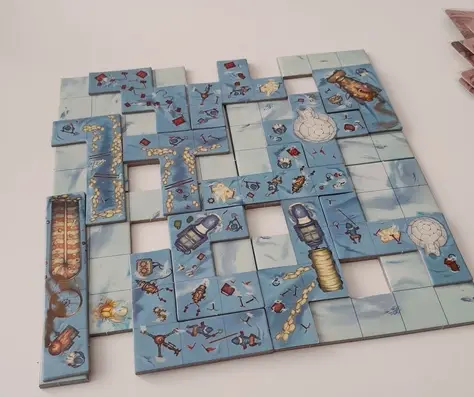Killing a Scarab
- Zerbique
- Jul 25, 2022
- 2 min read
Ever heard of Scarabya? Probably not. This is a fairly obscure title (designed by Bruno Cathala and Ludovic Maublanc) that has mostly been sold on the French market. It looks intriguingly similar to Knizia's My City and relies on the exact same gameplay core. Each player has a board and a set of polyominoes. Each turn, a card is revealed, showing a polyomino piece. Everyone then gets to place the piece on their board, until all cards have been revealed, all pieces placed or discarded, at which point the game ends and scoring occurs.

This is an interactionless, purely multiplayer solitaire thing, everyone doing their own affair on their board. As such, it is soloable straight out of the box - you just play to beat your own score. To get points, you must build out little enclosures of four squares or less, and you score points for each scarab symbol shown, each scarab bringing you as many points as the enclosure's total size. Simple! I got 46 on my first attempt. Of course, in solo, you have no clue as to whether this is a good score or not.

And, yes, I choose the Ice board because it's hot in here and I needed something refreshing. Also, you are supposed to fill the "holes" with little rock miniatures, which I consider to be absolutely useless and a waste of time to set up. The four board pieces are also supposed to be held together within a cardboard frame but despite my best efforts, I couldn't fit them in.
Polyomino bug-squashing
For some reason, however, the authors felt compelled to introduce a "proper" solo mode, that is, not a BYOS. In the solo mode, you need to cover EVERY scarab symbol (the game thus gets a win/lose condition). And of course it can get quite infuriating to miss the last one sitting in a corner, as happened in my first attempt...

And in my second attempt...

Well, at least the third time I got every single one of these nasty little critters. Polyomino bug-squashing at its best!

In all seriousness, the solo mode quickly feels limited, and the multiplayer mode played solo may prove more interesting in the long term. I don't know.
Lacking and limited
These spatial puzzle games are quite difficult to appreciate before you played them for real. They all sound pretty much similar and abstract, but for some the formula becomes fun and addictive (Tajemnicze podziemia, Oceania, Beacon Patrol), while others like this one, albeit perfectly clever and smooth and finely designed, lack some raw fun that will make replying the same core loop over and over weirdly addictive and satisfying. It's actually difficult to say why, but I suspect the small size of the board and the small number of pieces (only 12 and always the same 12) may explain why it feels so limited. Sure, the boards' orientation can change to provide some variability, but swapping a hole with a scarab won't change the game in a surprising and detectable way.
Well, in the end, it's pretty much what I expected it to be, but it lacks a spark to make me want to revisit it more than a few times, I'm afraid.

Since I have written this post, I have played several times the "multiplayer" version (which is soloable 'as is', provided you like to play BYOS style). It is indeed much better, more engaging throughout the game (it doesn't boil down to 'did I save the right piece at the end for this last scarab in the corner?'), with more variability in the outcome (because you get a score),
hence a greater margin to get better at it.
I don't know why some firmly entrenched views on solo gaming ("BYOS is not a real solo mode!") lead some designers/publishers to offer "solo variants" that will just put off most solo gamers, while they already have a decent game that they can…